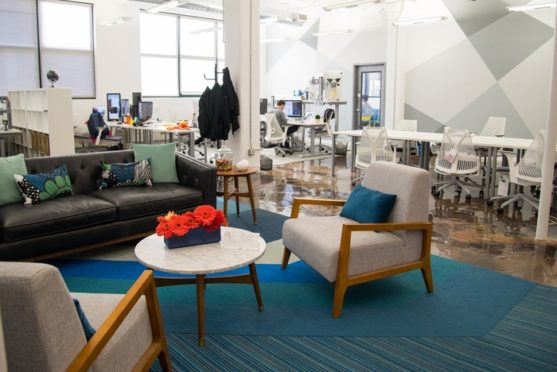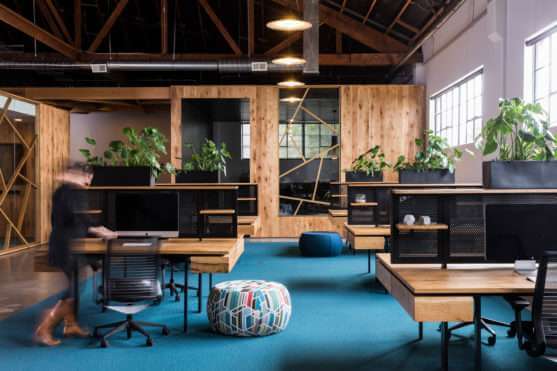Office space for lease comes in all shapes, sizes, and building classes. Even as many industries increasingly favor open floor plans and office space that accommodates them, there are plenty of types of office space that can fit your company’s needs. Here’s a quick overview of what’s available.
Traditional Office Space
For financial services firms, hedge funds, and law firms, the traditional office space layout is usually best. Traditional office spaces give employees quiet, private offices or areas to work and handle clients and confidential information, as well as collaborative, shared space. Common features of a traditional office include:
Reception | Boardroom | Bullpen | Private Offices
Most traditional office spaces require a multi-year lease (the industry norm is 3-5+ years). Therefore the classic office space is a good option if you are planning on staying in the space for the foreseeable future. Often uprooting employees can provide an unwanted disturbance to your staff’s everyday routine. For companies that value their privacy, traditional offices are usually more desirable than other options such as coworking.

Traditional office space layouts don’t have to be boring.
Creative Office Space
Recently, creative office space has become synonymous with open-plan office space, this could be in either traditional or coworking office space. Though they can vary drastically in style, decor, and layout, creative office space layouts tend to share a few common traits.
- Wood floors
- High ceilings
- Large windows
- Wet pantries
- Fewer walls & private offices
These types of office space layouts emphasize collaboration, on both a functional and symbolic level. With fewer barriers between departments and desks, they promise more transparency, communication, and collaboration between employees, managers, and leadership.
Creative office space also tends to be more space-efficient (depending on how it’s defined). As it pertains to square feet allocated per person, you can fit more employees at tables or rows in open space than individual cubicles or private offices.
Typically, startups, tech companies, and creative agencies have favored open office space, which spurred the trend for coworking office space. However large enterprise companies and even financial institutions have begun exploring this type of space to encourage and facilitate communication within and across teams.

Contiguous Office Space
What is contiguous space? Multiple suites on the same floor of a building that are combined and rented to a single tenant is “contiguous” space. Alternately, contiguous space can refer to suites located on multiple floors of a building that a single tenant rents. For example, a tenant could lease office space across floors 3-6 in a building. This type of office space is usually leased by larger businesses that need multiple offices or workplaces for different parts of the business but want them to remain in a similar area.
Coworking Space
Coworking offers flexible terms for use of a number of desks in an open office space and usually includes meeting and break-out rooms. They primarily serve small companies and startups in need of workspace for indefinite periods of time. Coworking space can be secured by desk per day, all the way up to yearly terms. Shared amenities, spaces, and appliances help keep costs low. Longer commitments will ensure lower rent prices, but depending on your situation it may be worth paying a premium for the flexibility.
In addition to the flexible lease terms and collaborative workspace, coworking spaces often encourage social interaction between tenants in the form of organized events, panel discussions, and happy hours.
As is the case with any open office space, what you gain in flexibility, cost, and socializing you often lose in privacy. Furthermore, as a company grows, the need for exclusive workspace often emerges.
Shared Office Space
A shared space arrangement is one in which a company with extra space in its office leases a portion of the space out to another company. This situation is generally a win-win for both parties, as it allows the main tenant to recoup some of their office space overhead costs, while the subtenant is able to enjoy reduced rents and more flexible lease terms. Additionally, this provides some of the social benefits of coworking, but still allows both companies to maintain some degree of control, since they know their neighbors. Shared space marketplaces like PivotDesk make it easy to both advertise and find shared space.
Executive Suites
Executive suites can come as fully serviced workspace nestled within a full floor of space that has been leased to another company. You can often secure executive suites as a sublet with flexible terms. Most private office suites will offer month-to-month rent or terms in 3, 6, 9, and 12-month increments.
On top of coming fully furnished and pre-wired for phone and internet services, the perks of an executive suite include access to a common conference room and break room and a reception area with a receptionist. This means you are all set up without the worry of planning an executive office layout.
Understanding Types of Office Building Classifications
Building classes serve as signals of a building’s amenities, architecture, location, and of course, cost to rent. Whether it is a small or large office space you are looking for, the building class evaluates the building, not the office space.
Most office buildings fall into one of four categories: Trophy, Class A, Class B, or Class C. However, this classification system is far from an exact science. There are no industry-wide standards or benchmarks of what makes a building one class or the other — the distinction varies by market, and by what other buildings are in the neighborhood.
The common factors that decide what class a building falls into are building age, location, curb appeal, historical significance, maintenance, ownership, building infrastructure IT, HVAC, plumbing, etc.), and construction awards (such as LEED certification).
Building classifications aren’t set in stone — a commercial property can move up or down the classification tiers based on market trends or renovations.
Not sure which of the different types of office space is best for your company? No need to worry — this will vary by your company size, budget, and growth plans over the next few years. Your best option is to start by comparing vacancies with a licensed tenant broker.
Article updated on August 14th, 2019



